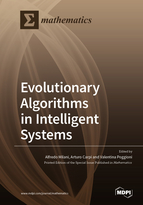Evolutionary Algorithms in Intelligent Systems
A special issue of Mathematics (ISSN 2227-7390).
Deadline for manuscript submissions: closed (30 August 2020) | Viewed by 32524
Special Issue Editors
Interests: algorithms on strings; formal languages; automata theory; code theory; word combinatorics
Interests: online evolutionary algorithms; metaheuristic for combinatorial optimization; discrete differential evolution; semantic proximity measures; planning agents and complex network dynamics
Special Issues, Collections and Topics in MDPI journals
Interests: evolutionary computation; evolutionary algorithms in neural networks and machine learning; neuroevolution; sentiment analysis; distributed autonomous agents; automated planning
Special Issue Information
Dear Colleagues,
Evolutionary algorithms and metaheuristics are widely used to provide efficient and effective approximate solutions to computationally hard optimization problems. Successful early applications of the evolutionary computational approach can be found in the field of numerical optimization, while they have now become pervasive in applications for planning, scheduling, transportation and logistics, vehicle routing, packing problems, etc. With the widespread use of intelligent systems in recent years, evolutionary algorithms have been applied, beyond classical optimization problems, as components of intelligent systems for supporting tasks and decisions in the fields of machine vision, natural language processing, parameters optimization for neural networks (neuroevolution), and features selection in machine learning systems. Moreover, they are also applied in areas like complex networks dynamics, evolution and trend detection in social networks, emergent behavior in multiagent systems and adaptive evolutionary user interfaces, to mention a few. In these systems, the evolutionary components are integrated in the overall architecture and they provide services, e.g., pattern matching services, to the specific algorithmic solutions.
The aim of this Special Issue is to bring together recent theoretical and applicative research advancements in the area of evolutionary algorithms as components of intelligent systems, with a focus on solutions and methodologies that can be reused to solve sub-classes of problems recurring in intelligent applications.
Contributions are welcome on theoretical models and applications to intelligent systems of evolutionary algorithms for, but not limited to, single-objective and multi-objectives optimization, numerical continuous non-linear optimization, combinatorial optimization, graph matching and pattern matching, agents and automata optimization. Evolutionary paradigms to be considered, non-exhaustively, include continuous and discrete differential evolution, genetic algorithms, memetic and foraging schemes, online evolutionary algorithms, genetic programming, co-evolution mechanisms, artificial immune systems, swarm based approaches, ant colony optimization, and, more generally, nature and bio-inspired meta-heuristics.
The selection criteria will be primarily based on the formal and technical soundness, the experimental support and the relevance of the contribution and its impact on re-usability of the results for solving subgroup of problems recurring in a class of intelligent applications.
Prof. Dr. Arturo CarpiProf. Dr. Alfredo Milani
Dr. Valentina Poggioni
Guest Editors
Manuscript Submission Information
Manuscripts should be submitted online at www.mdpi.com by registering and logging in to this website. Once you are registered, click here to go to the submission form. Manuscripts can be submitted until the deadline. All submissions that pass pre-check are peer-reviewed. Accepted papers will be published continuously in the journal (as soon as accepted) and will be listed together on the special issue website. Research articles, review articles as well as short communications are invited. For planned papers, a title and short abstract (about 100 words) can be sent to the Editorial Office for announcement on this website.
Submitted manuscripts should not have been published previously, nor be under consideration for publication elsewhere (except conference proceedings papers). All manuscripts are thoroughly refereed through a single-blind peer-review process. A guide for authors and other relevant information for submission of manuscripts is available on the Instructions for Authors page. Mathematics is an international peer-reviewed open access semimonthly journal published by MDPI.
Please visit the Instructions for Authors page before submitting a manuscript. The Article Processing Charge (APC) for publication in this open access journal is 2600 CHF (Swiss Francs). Submitted papers should be well formatted and use good English. Authors may use MDPI's English editing service prior to publication or during author revisions.
Keywords
- Evolutionary components in artificial intelligent systems
- Evolutionary machine vision
- Evolutionary approaches to combinatorial optimization
- Formal methods in evolutionary algorithms
- Evolutionary algorithms in machine learning
- Evolutionary agents and planning
- Evolutionary hardware and robotics
- Evolutionary schemes for crowd modeling and management
- Evolutionary approaches to social network dynamics
- Neuroevolution and evolutionary algorithms in neural networks
- Evolutionary strategies for cybersecurity
- Evolutionary human-machine and machine-machine interfaces







